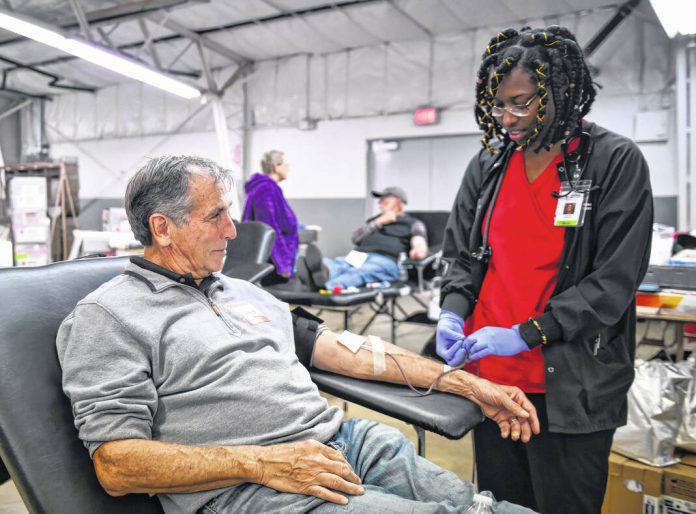
Phlebotomist Laysha Hawkins monitors Greg Bukowski as he donates blood May 17, 2023 during a blood drive at the Auglaize County Fairgrounds. The American Red Cross declared an emergency blood shortage in January as the number of people donating blood through the Red Cross has reached a 20-year low.
The Lima News file photo
LIMA — The American Red Cross declared an emergency blood shortage in January as the number of people donating blood through the Red Cross has reached a 20-year low.
The organization, which now sees 40% fewer blood donors than it did two decades ago, declared an emergency earlier this month after it reported a 7,000-unit shortfall in blood donations between Christmas and New Year’s Day.
The Red Cross is the largest supplier of blood products to hospitals across the U.S., including Lima Memorial Health System and Mercy Health-St. Rita’s Medical Center.
The decline in donations to blood banks like the Red Cross in recent years has led Lima hospitals to share supplies with other hospitals in Northwest Ohio and to monitor blood utilization within their facilities so that blood products are readily available for emergencies, transplant recipients and cancer patients.
“It’s not a dire shortage we’re experiencing, but we do watch our decisions to make sure that we’re being judicious with that blood product use when we can be,” said Dr. Matthew Owens, chief clinical officer for Mercy Health-Lima.
Sharing between hospitals also ensures that blood products, which have a limited shelf life, don’t go to waste, Lima Memorial Lab Director Sam Schroeder said.
“The last thing you want to be told is that your donated (blood) was thrown away,” Schroeder said.
“There’s very, very little wastage in the hospitals through that system of sharing and utilization and making sure you have what you need but not too much.”
The Red Cross has raised alarm for several years about the decline in blood donations, which it attributes to a combination of stricter eligibility requirements for blood donors and changing work habits that have led to fewer workplace blood drives.
Holidays, inclement weather and season illness often disrupt the rate of donations to blood banks as well.
Red Cross officials warn that the overall decline in people giving blood means that “even small disruptions to blood donations … can have a huge impact on the availability of blood products and dramatic consequences for those in need of emergency blood transfusion.”
Gov. Mike DeWine joined the Red Cross and the head of Ohio’s emergency medical services earlier this month in calling on Ohioans — particularly those who are type O — to donate blood amid the national shortage.
“The greatest concern is that some patients may not be able to receive life-saving infusions of blood and blood products,” Ohio EMS Executive Director Rob Wagoner said in a press release about the shortage. “This affects not only emergency medical situations, but can also put other necessary medical procedures on hold.”
Blood donors are eligible to return to give blood every eight weeks, while those who donate two units in one visit must wait 16 weeks before returning, Schroeder said.
The Red Cross asks donors to bring a donor card, driver’s license or two other forms of identification to their appointment.






